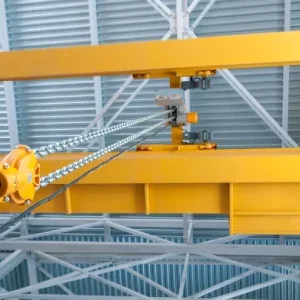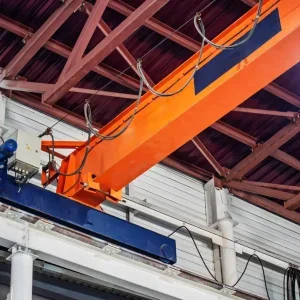Such was the plethora of new product on display at the Hannover Fair in Germany back in March that HOIST has still not yet had adequate opportunity to report fully on all the innovations that were introduced to the market at that event.
Among the launches was a new family of remote control systems from the Spanish manufacturer Ikusi. The TM 60 range, which supersedes the TM 50, is the result of three years of research and development and about $2m investment and was launched at the Hannover Fair in March.
Ikusi says that the main improvements are in ergonomics and safety. Ergonomic features include a rubberised hand grip on the console box transmitters which allows the operator’s hands to rest during operation.
Other new features include tele-alignment of analogue outputs, allowing the operator the facility to select the speed of the equipment from the actual transmitter unit during initial set-up. The TM 60 also allows special applications such as pitch-and-catch, crane sharing or tandem control.
The TM 60/1 and 60/2 push-button remote control transmitters are designed to replace conventional pendants used in lifting machinery. The TM 60/3 and 60/4 console transmitters with joysticks are designed for overhead and tower crane applications. TM 60/5 and 60/6 are designed for use with concrete pump trucks, while the TM 60/7 and 60/8 have paddle joysticks and are for mobile cranes that operate hydraulically using proportional valves.
“A unique feature to the TM 60,” according to the manufacturer, is the possibility for true range control, as reported in the April/May issue of HOIST. Ikusi’s new LA 60 range limitation system, an option with TM 60, combines the benefits of infra-red and radio systems, the company says, and so has advantages not yet offered by any competitors. The LA 60 was developed initially for British Steel which wanted a system that could not be misused by operators. It detects if the remote control transmitter is outside a predetermined safe working area and if so disconnects the controls, after first giving an alarm. The main contactor however, remains on so that a radio link is maintained and operational control resumes automatically when the operator returns to the working area.
The system uses one or more LA 60 transmitter units that emit an infra-red beam in which a receiver, mounted on the remote control console or pendant, has to be present to operate the system. The accessory can be added to existing Ikusi remote controls and can be used instead of an infra-red key system.
From Germany, Dematic has a new RC-J joystick radio control, primarily aimed at more complex triple axis crane applications. It has pulse width modulated output signals and it complements the range of push button controllers.
Also from Germany this year is HBC’s FST 515 Micron 5, a smaller, lighter and less expensive version of the FST 716 system. Where the 716 transmitter has a key switch, the 515 transmitter is switched on by pressing a combination of buttons. Another difference is that the receiver on the 515 cannot switch between different power supplies.
Other developments from HBC this year include the Micron 4, which is equipped with 10 two-step pushbuttons and up to two rotary switches/ momentary rotary contacts and fully enclosed in shock protection.
Standard version of the Micron 4 can control up to four crane drives and transmit up to 24 operating commands, compared with 16 on the Micron 3. It can also be equipped with a five-step rotary switch that permits the operator to alternate between tandem and pitch-and-catch modes.
Also now available from HBC are explosion proof versions of the larger systems, the 770 Spectrum and 735 Spectrum, for Zone 1 applications. Additionally, it has begun selling 735 systems with Profibus interface. The first prototype unit has been sold with a Dematic crane to a harbour in Antwerp, Belgium. If all goes well, it is the first of a 200 unit order.
As previously reported, Italian manufacturer Ravioli SpA showed a new radio remote control unit at Hannover, called the Dual. The IP 65-rated model, which features joysticks and push buttons, can change working frequency directly from the console with the receiver automatically aligning with it.
Ravioli claims that the small receiver unit is protected against knocks and leakages, and is easy to install thanks to a removable terminal board. It is equipped with interface cards, including relay outputs, proportional outputs and outputs for inverters.
The design of a new range of enhanced safety push button remote controls from Jay Électronique allows adaptation for diverse applications including tower cranes, factory lifting and handling equipment, industrial vehicles and other factory machinery. Many different configurations are therefore necessary. There is a choice of four, six, eight or 10 button units, the functions of which can include single or double speed, and rotary switches with two or three positions and automatic return. The number of output relays can be specified as either nine, 15 or 21.
Ergonomic transmitter design allows for one-handed operation, while mechanical protection prevents inadvertent operation of the function buttons. A trained operator can switch between 64 frequencies in the 433MHz band and the system has infra-red start up validation, electronic key access and a monitoring function.






